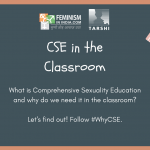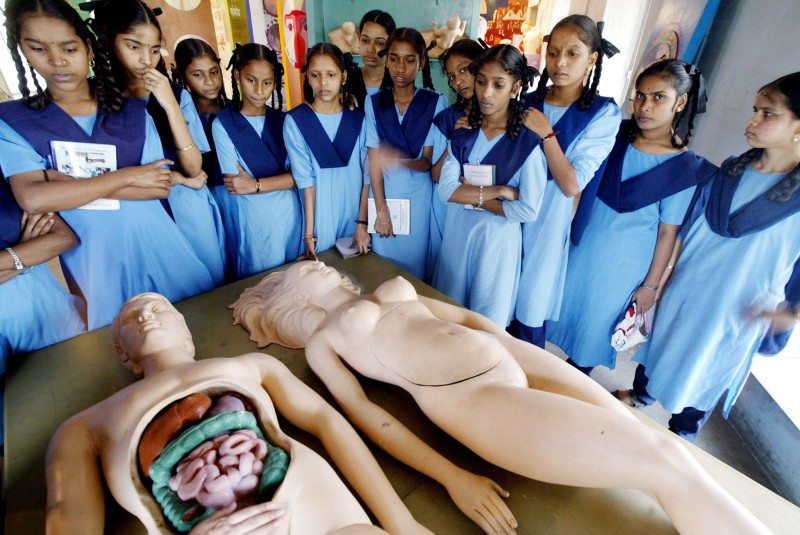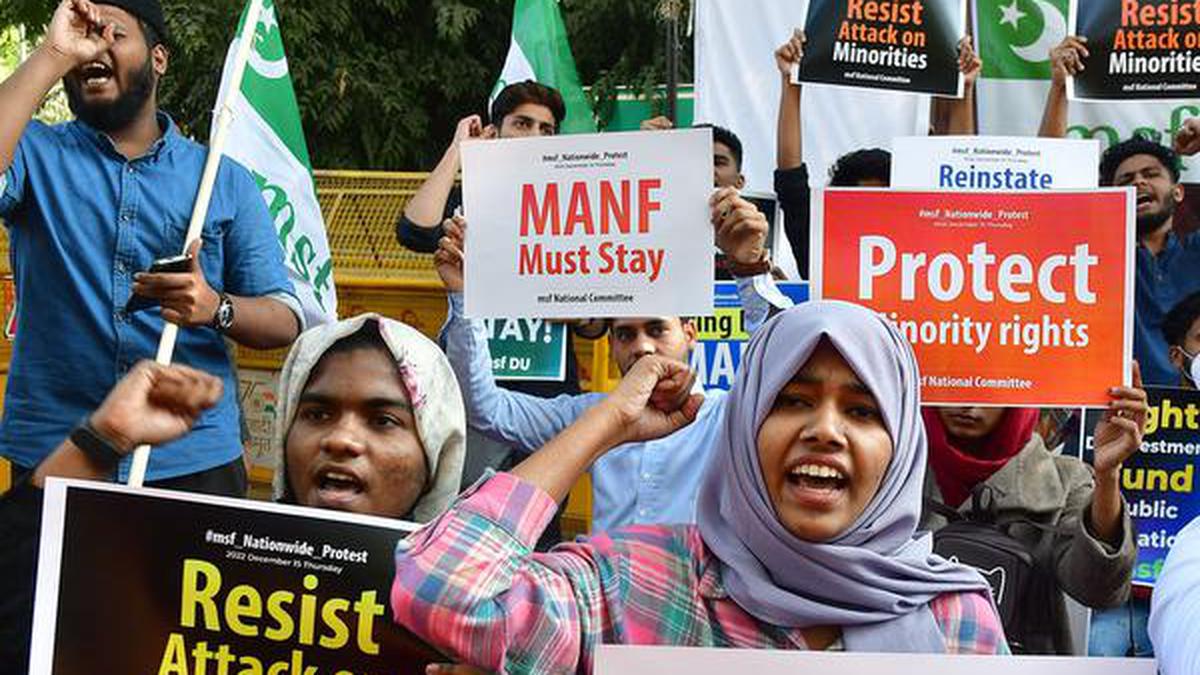 Editor’s Note: Feminism in India in collaboration with TARSHI have launched a campaign ‘#WhyCSE – CSE In The Classroom’ to emphasize the need for Comprehensive Sexuality Education in schools. Read more about the campaign here.
Editor’s Note: Feminism in India in collaboration with TARSHI have launched a campaign ‘#WhyCSE – CSE In The Classroom’ to emphasize the need for Comprehensive Sexuality Education in schools. Read more about the campaign here.Posted by Ishita Chaudhry
Comprehensive Sexuality Education in India is a mixed bag at best – some states implement a formal curriculum, some prefer not to; some private schools call specialists to provide information about reproductive health and adolescence while others believe this is strictly unnecessary. All along, teachers – who are instrumental in shaping school and childhood/adolescence experiences – are often left out in the business of transacting important information related to sexuality with children and young people.
Teacher training courses typically ignore sexuality education, and few schools – and teachers themselves – believe that teachers are to take additional time out of their ever-growing lists of tasks to include sexuality education. But why do we have to envision CSE as a separate subject? Where do we give space for teachers to know about sexuality, what it entails, and clarify their doubts? Why do we not believe that just like knowing how to teach language, Mathematics, Geography or Chemistry, teachers need to know how to talk sexuality with young people?
Where do policy and advocacy come in here, to aid teachers in discussing CSE related topics with young people? This article by Ishita Chaudhry traces some programmes, advocacy efforts and curricula that have been developed over the last decade in India related to CSE (or some of its components), their attitudes towards training teachers or changing textbook lessons, and the role of civil society in advocating for decreased cultural and political resistance to CSE.
***
“There is no thing as a single issue struggle, because we all do not lead single issue lives.” – Audre Lorde
The landscape of implementing Comprehensive Sexuality Education (CSE) in India seems to be iteratively stuck with the same challenges – we know that providing clear, accurate information is effective in advancing and protecting young people’s Sexual and Reproductive Health and Rights but we don’t have the greatest evidence on what works in scaling CSE programmes. There is a mystifying lack of incentives in place to teach it and we have not yet cohesively tackled social discomfort and belief systems that are rooted in the idea that this information is ‘dangerous’ or even worse, unimportant.
We know that what is taught as CSE differs from district to district, and how it is explained in the classroom is substantively impacted by teachers who often struggle with delivering CSE curriculums, with limited access to and use of effective local teaching aids. We also know that didactic approaches to CSE do not work. Rather it is interactive, user-centered approaches that ground theory in real life and gives young people the skills to develop their thinking and access knowledge without stigma and judgement.
Where we begin, and where we struggle
In the paper I have spent the last few months reviewing for TARSHI on mapping the state of Sexuality Education within schools in India, stakeholder interviews repeatedly explore the need for civil society organizations, educationalists, state education and health services to bring a consolidated approach to the table*. What kinds of partnerships need to be cross-held so we can make the need for CSE understood and ensure it is accessible to children, young people and adults across a life cycle continuum? How can we shift the understanding of CSE from just within the context of disease-prevention, preventing gender based violence, early and forced marriage, unwanted pregnancies, HIV and unsafe abortions – a tall order in and of itself – but also to advancing individual and social mobility, confidence in one’s self and bodily integrity, developing sex positive attitudes, an understanding of pleasure, diversity and strengthening interpersonal relationships at multiple levels?
Advancing CSE in the in and out-of-school landscape
Although 12-13 states banned the Adolescence Education Programme (AEP) after its introduction between 2007-2009 by the (then) central government, 2010 to 2014 witnessed a concerted pushback by civil society to reverse these bans. These were met with some measure of success, with the ban currently standing in only 6 states†. The AEP is the largest in-school national curriculum that addresses sexuality education in India, with several states implementing their own versions of the same. Designed and implemented in partnership between UNFPA and NCERT, the AEP went through an evaluation in 2009, and its survival through political turmoil is no mean feat.
In 2013 both Verma Committee recommendations on the need to implement age appropriate sex education, as well as to criminalize marital rape were squarely rejected by parliament, who cited the need to defend women and girls’ honour and safety, not by enabling their access to information, but by reinforcing cultural morality and the sanctity of the institution of marriage, seemingly unconcerned with ideas of consent and bodily integrity within the same.
While public feedback across 2014 to 2016 saw several central public figures display hesitation on AEP and its implementation‡, revisions to the AEP curriculum have since been underway. This has gone hand in hand with the sustained advocacy of the Shiksha Bachao Andolan Samiti with the HRD Ministry to substitute sex education for children in schools with sports and the mandate for revised National Education Policy in 2016 dropping the expert committee recommendation for “sex education in schools for adolescent(s) for safety measures”. In the backdrop of several state and central textbooks, including higher education textbooks that advance stereotypes and gendered stigma and discrimination, the National Council for Education, Research and Training (NCERT) has been drafting new chapters for classes 1 to 5 with a focus on preventing Child Sexual Abuse as well as a revised approach to addressing gender, discrimination and sex education, in the context of understanding self, one’s surroundings and navigating relationships.
A curriculum titled ‘Health and Physical Education’ developed for classes 1 to 12 includes teaching-learning aids such as case studies, comics, films, group activities and access to counsellors. The curriculum also faced pressure to include mandatory education on yoga, eventually rejected by the HRD Ministry and stayed by the Supreme Court as per the guidelines of the Right of Children to Free and Compulsory Education (RTE) Act, 2009, and the National Curriculum Framework (NCF).
One step back, two steps forward
A key opportunity to operationalize CSE for adolescents in the out-of-school context was the 2014 launch of India’s ambitious national strategy on adolescent health, the Rashtriya Kishor Swasthya Karyakram (RKSK). Under RKSK, Haryana’s state department of Human Resource Development, Women and Child Development and Health have collaboratively designed a sex education programme for classes 8 to 12, with the aim of expanding the same across anganwadi centers in the future. The state is focussing on key aspects of socializing such a curriculum, including training team members of the project and teachers on how best to sensitize students§.
Recently, the Saathiya programme was launched under the RKSK to train 1.6 lakh peer educators to work with community health workers to generate demand for adolescent health services, and provide information on CSE-related issues through peer groups. These peer educators will have as support a resource kit (an activity book, games, a peer education diary and a Q&A booklet) and a mobile application for adolescents called Saathiya Salah. Saathiya’s content includes the expected information on substance abuse, STIs, gender stereotyping, gender based violence and contraception, but makes significant strides in acknowledging desire as normal across and between different genders, with a key focus on consent, a most welcome step forward in public health programming.
While diversity remains one of the core values of CSE, understanding Sexual Orientation Gender Identity and Expression is most often the most ostracized and ignored component of teaching CSE programmes. The shift towards challenging gender and moving away from regressive notions of masculinity, violence and identity is critical if CSE is to advance from simply providing information to influencing attitudes and behaviour change.
The need for cross-movement partnerships and learning
What is rare (and where more collaborations are needed) is advocacy for CSE from beyond the public health and education sector. Kailash Satyarthi’s national campaign ‘Surakshit Bachpan, Surakshit Bharat’, focused on combating violence against minors, has placed with state governments a demand for basic sex education to address sexual assault and pornography.
Similar calls have been echoed recently by victims of Child Sexual Abuse (CSA) as well as most recently on the country’s Independence day, projecting CSE as having the potential to help young people understand sexual violence and how they can protect themselves. Despite data from UNICEF citing that a child under 16 is raped every 155 minutes in India, and a child under 10 years of age every 13 hours, with 240 million women living in India as child brides, there is still tremendously poor political value on the lives of young women and girls. The Supreme Court’s shocking judgement recently, to deny an child of 10 years the right to abort a foetus on the grounds that she was past 32 weeks, forcing the adolescent to take her pregnancy to term, is testament to that.
There is tremendous value in creating learning dialogues between (and within) education systems that are struggling with adapting and scaling content on CSE and the experiences of several small-scale, CSO-led CSE programmes. Urmi Foundation and Point of View for example, are leading critical conversations on how we build CSE programmes to address the sexual rights of young people living with disabilities, while bilingual platforms like Love Matters and Agents of Ishq are localizing conversations on sex and sexuality. While there are differences in scale and outreach in both contexts, it is only by advancing cross learning in how we ‘normalize’ what we find challenging about implementing CSE that will create entry points in a wider national landscape to shift current mindsets on sex and sexuality in public health and education policy. Without bringing together different kinds of stakeholders together, this is not possible.
Bringing the macro, to the micro
The pathways to sustaining designing, implementing and scaling CSE in India rests squarely on the need to change social behaviours, thoughts and attitudes about adolescent and young people’s sexuality and agency. CK Misra, the Secretary of Health for the Ministry of Health and Family Welfare has acknowledged that making a dent in this space, by influencing the communities in which 285 million adolescents live would be a major contribution to advance public health, and is no small feat to achieve. This cannot be done without the leadership of adolescents and young people themselves. When user-generated demand for information and services has social legitimacy and political traction, health and education systems are pressured to develop, finance and sustain infrastructure that is well equipped to cater to these needs. Particularly if these issues land as top priorities on a young electorate’s agenda.
Endnotes
* Author’s caveat: There is no one way to piece together the narrative on the policy history of CSE in India. A lot depends on how linkages are observed and understood and this article picks on some of these policy threads. TARSHI’s upcoming paper assessing the status of CSE in India has a more expanded view of the same.
† At last count, Maharashtra, Gujarat, Rajasthan, Madhya Pradesh, Chhattisgarh, and Karnataka, but this list is likely to have reduced.
‡ Noteworthy are Dr. Harsh Varshan’s alleged ban on the AEP with an alternative format for Delhi schools proposed and the HRD Ministry’s discomfort with the AEP and references to sex in policy mandates in 2016.
§ The curriculum focuses on providing information on SRH, gender violence, nutrition, substance abuse and mental health for adolescents, with the progressive view of normalizing sex instead of placing it within aberrant behaviour in an attempt to tackle the stigma around the issue.
Ishita Chaudhry is an Ashoka and INK Fellow and Founder and Managing Trustee of The YP Foundation, a youth-led organization that builds feminist leadership to advance the rights of young women, girls and other marginalized youth in India. Currently an independent consultant, she works with governments, civil society organizations and youth groups on developing policies and programmes that advance young people’s access to SRHR, health and education.
Featured Image Credit: Arko Datta/ Reuters




